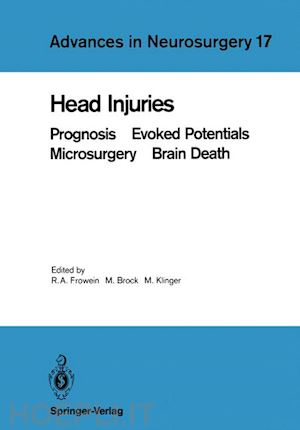The Development of Orbital Surgery from a Neuro surgeon ’s Viewpoint.- Head Injuries — Long-Term Results — Prognosis.- Long-Term Outcome After Severe Head Injury in Children and Young Adults.- Outcome After Severe Head Injury with Midbrain Syndrome in the Acute Stage.- Comparison of Magnetic Resonance Imaging, X-Ray Computed Tomography, Electroencephalography, and Long-Term Outcome After Head Injury: A Prospective Reexamination of 55 Patients.- Longlasting Coma After Head Injury: Late Results.- Traumatic Intracranial Hemorrhages in Elderly People.- Outcome of Patients with an Acute Traumatic Sub- dural Hematoma.- Acute Subdural Hematoma — An Unsolved Neuro- surgical Problem.- Regeneration of Intellectual Functions Following Closed Brain Injury: Follow-up Study on a Pair of Twins Using the Co-twin as Control.- The Influence of Independent Parameters on the Evaluation of Patients with Craniocerebral Trauma and Their Occupational Reintegration.- Prognostic Parameters in Severe Head Injury: A Multivariate Analysis.- Prognostic Value of Factors Affecting Outcome After Severe Head Injury.- Organizational Model for the Diagnosis and Treatment of Skull and Brain Injuries at a Neuro- surgical Clinic with an Integrated Neororadio- logical Department.- Frequency and Prognosis of Traumatic Brain Edema.- ICP, nrCBF, and Contrast Scan for the Prognosis of Severe Head Injury.- Head Injuries — Evoked Potentials.- Value of Multimodality Evoked Potentials in the Diagnosis of Skull/Brain Injuries in Neuro- surgical Intensive Care Units.- Somatosensory Evoked Potentials: Diagnostic and Prognostic Value in Head Injuries.- Prognostic Significance of Somatosensory Evoked Potentials in Traumatic Brain Stem Lesions.- On the Prognosis of Severe Head Injury Using Multimodal EvokedPotentials.- Isolated Traumatic Lesions of Ventricular and Periventricular Regions and Cerebral Midline Structures: Outcome Prediction by CT Scan, Evoked Potentials, and ICP Monitoring.- The Prognostic Importance of Somatosensory Evoked Potentials, Computed Tomography, and Clinical Findings in Severe Head Trauma.- Microsurgery.- Anatomy in and on the Jugular Foramen.- Branchial Paragangliomas.- Surgery of the Jugular Foramen.- Microsurgical Approaches to the Cavernous Sinus.- A Combined Transsylvian-Subtemporal Approach for Management of Tumors Located in the Cavernous Sinus and in Meckel’s Cave.- Microsurgical Resection of Tumors Involving the Cavernous Sinus: Possibilities and Limitations.- Anesthesia-Independent Facial Nerve Monitoring with Orthodromic Intra/Extracranial Neurography.- Clinical Subtyping of Trigeminal Neuralgia and Its Correlation to the Intraoperative Findings and Surgical Results Following Microvascular Decompression.- Neurovascular Compression as a Cause of Essential Hypertension: A Microanatomical Study.- Essential Hypertension in Patients with Hemi- facial Spasm or Trigeminal Neuralgia.- Neurosurgical Topography of the Pyramidal Tract.- Postoperative Mortality in the Era of Microneu- rosurgery.- Incidence, Management, and Outcome of Patients with Premature Rupture of Cerebral Aneurysms During Surgery.- Temporary Vessel Occlusion by Microvascular Clips.- Aneurysmal Location and Operative Timing.- Ventral Transvertebral Intradural Approach in Cervical and Thoracic Lesions.- Lateral Approach for Resection of Anterior Craniospinal Tumors-.- Brain Death.- Diagnosis of Brain Death.- Differentiated Diagnostic Measurements in Determining Brain Death in Clinical Practice.- Neurosurgical Diagnosis of Brain Death in the Peripheral Hospital PrecedingMultiorgan Donation.- Experience with Determination of Brain Death and Organ Donation.- On Problems in the Determination of Brain Death.- Latency of Recovery and Electrical Silence of Auditory Evoked Potentials and the Electro- corticogram After Peracute Complete Brain Ischemia of 2-30 Minutes’ Duration.- Methodological and Technical Problems in the Confirmation of Brain Death by Evoked Potentials.- Nasopharyngeal Recording of Subcortical Somatosensory Evoked Potentials in Brain Death.- Is the Loss of Evoked Potentials and Brain Stem Reflexes as Investigated Electrophysiologically Proof of Brain Death?.- Multimodality Evoked Potentials in the Diagnosis of Brain Death.- The Value of Motor Potentials Following Trans- cortical Stimulation in Diagnosing Brain Death — First Results.- Motor-Evoked Potentials and Transcranial Doppler Sonography During Development of Cerebral Circulatory Arrest.- Neuropathology of Brain Death in Relation to Continuously Measured Intracranial Pressure.- The Use of Transcranial Doppler Ultrasound Monitoring in the Determination of Brain Death.- Comparative Evaluation of Angiography and Transcranial Doppler Sonography in the Determination of Intracranial Circulatory Arrest.- Hemodynamics of Cerebral Circulatory Arrest: Correlation Between Perfusion Pressure and Blood Flow Velocity.- Comparison of Transcranial Doppler Sonography and Cerebral Angiography for the Diagnosis of Cerebral Circulatory Arrest.- Electrographic Changes in Brain-Dead Patients.- Brain Death in Fulminant Hepatic Failure.- Ethical and Legal Aspects of the Diagnosis of Cerebral Death in the GDR.- Brain Death Diagnosis in Anencephalics?.- New Research.- Monitoring of Hemodynamics in Subarachnoid Hemorrhage Using Transcranial Doppler and Laser Doppler.- Cerebral Blood FlowMeasurements with 99mTc-HMPAO and 123I-Amphetamine (HIPDM) in Patients with Cerebral Tumors (1).- CSF Flow Visualization by Magnetic Resonance Imaging Techniques — Methods and Clinical Examples.- Intracranial Complications After Anticoagulant Therapy.











